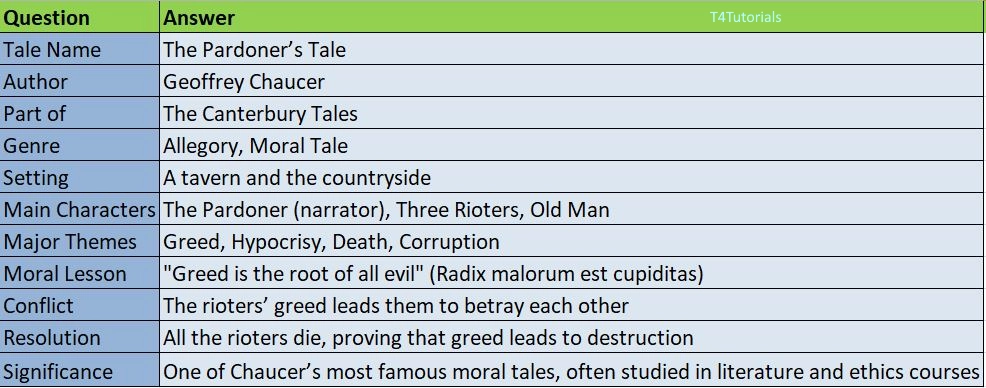Summary:
“The Pardoner’s Tale” is one of the best-known stories from The Canterbury Tales by Geoffrey Chaucer. It is an allegorical tale about greed and its consequences, told by the Pardoner, a corrupt church official who sells indulgences (pardons for sins). Although he openly admits to his own hypocrisy and greed, he still preaches against these very sins.
The tale begins with three young men (rioters) in a tavern who learn that Death has been killing many people in their town. They set out on a quest to find and kill Death. Along the way, they meet an old man who tells them they can find Death under an oak tree.
When they reach the tree, they do not find Death but instead discover a pile of gold coins. Greed overtakes them, and they plot against one another to take all the gold. Two of them secretly plan to kill the third when he returns with food and wine. Meanwhile, the third man poisons the wine, hoping to keep the gold for himself.
When the third man returns, the two attack and kill him. They then drink the poisoned wine and die as well. In the end, all three meet their death, proving that greed leads to destruction.
After telling the tale, the Pardoner tries to sell pardons to the pilgrims, showing his hypocrisy. The Host angrily refuses, and the tale ends with tension among the group.

Score: 0
Attempted: 0/10
Subscribe
| Question | Answer |
| Tale Name | The Pardoner’s Tale |
| Author | Geoffrey Chaucer |
| Part of | The Canterbury Tales |
| Genre | Allegory, Moral Tale |
| Setting | A tavern and the countryside |
| Main Characters | The Pardoner (narrator), Three Rioters, Old Man |
| Major Themes | Greed, Hypocrisy, Death, Corruption |
| Moral Lesson | “Greed is the root of all evil” (Radix malorum est cupiditas) |
| Conflict | The rioters’ greed leads them to betray each other |
| Resolution | All the rioters die, proving that greed leads to destruction |
| Significance | One of Chaucer’s most famous moral tales, often studied in literature and ethics courses |